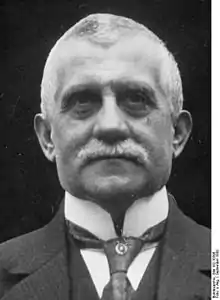Émile Moreau | |
|---|---|
 Governor of the Banque de France, 1926-1930 | |
| Born | September 29, 1868 |
| Died | November 9, 1950 |
| Nationality | French |
Émile Moreau (September 29, 1868 – November 9, 1950) was Governor of the Banque de France from 1926 to 1930 and chairman of Paribas from 1931 to 1940. After retiring from his role as governor he took a job in a private bank. His contribution to the Poincare Stabilization helped the French Franc to gain credibility in the 1920s following the Russian Default post the Bolshevik Revolution. As pointed out in his memoirs,[1] Emile Moreau took active measures to increase French influence in Eastern Europe. It was under his governorship that French Money Doctors were sent to Romania as advisors.[2]
Finance Ministry
In 1902 French Finance Minister Maurice Rouvier chose Moreau as his chef de cabinet. He served numerous positions within the French civil service, including was Inspector General of Finance in 1896, Chief of Staff of the Minister of Finance in 1902, and Director General of the Banque de l'Algérie. While at the Ministry of Finance, he presided over an international community that would oversee the repayment of debts from the First World War.
Banque de France
Moreau was the Governor of the Banque de France from 1926 to 1930. The preceding years were marked by hyperinflation in Germany and contention over the German reparation issue. As such, he led efforts at the Bank for the stabilization of the Poincaré franc in 1926 and was an avid supporter of de facto devaluation.[3] This involved a negotiation with several international banking firms for a loan that would allow the Bank to defend the franc from severe exchange-rate fluctuations.[4] Moreau also advocated the accumulation of gold reserves in the years leading up to the Great Depression, as well as create a stabilization fund (fonds de stabilisation). He sought to establish the Banque de France as an international leader in monetary policy, comparable to the likes of the Bank of England and the Reichsbank.[5]
Moreau retired in 1930 and was succeeded by Clément Moret. In 1935 he became the chairman of the State Bank of Morocco.
References
- ↑ Moreau Emile, (1954), Souvenirs d'un Gouverneur de la Banque de France. Histoire de la stabilisation du Franc (1926-1928), Editions Genin, Paris
- ↑ Torre, Dominique. "Charles Rist and the French missions in Romania, 1929-1933. Why the "Money Doctors" failed?" (PDF). National Bank of Serbia. Fourth Conference of Southeast Europe Monetary History Network.
- ↑ Mouré, Kenneth (1996). "Undervaluing the Franc Poincare". The Economic History Review. 49 (1): 137–153. doi:10.1111/j.1468-0289.1996.tb00561.x.
- ↑ Yee, Robert. "The Bank of France and the Gold Dependency: Observations on the Bank's Weekly Balance Sheets and Reserves, 1898-1940" (PDF). Studies in Applied Economics. Johns Hopkins University.
- ↑ Pease, Neal (1986). Poland, the United States, and the Stabilization of Europe, 1919-1933. New York: Oxford University Press. pp. 87.
Further reading
- Accominotti, Olivier. “The Sterling Trap: Foreign Reserves Management at the Bank of France, 1928-19.” European Review of Economic History Volume 13, Number 3. 2009. .
- Ahamed, Liaquat. Lords of Finance: The Bankers Who Broke the World. New York: Penguin Books. 2009. ISBN 978-1-59420-182-0.
- Moreau, Emile. "Souvenirs d'un Gouverneur de la Banque de France. Histoire de la stabilisation du Franc (1926-1928)." Paris: Editions Genin. 1954.
- Mouré, Kenneth. “The Gold Standard Illusion: France and the Gold Standard in an Era of Currency Instability, 1914-1939.” In Crisis and Renewal in France, 1918-1962, eds. Kenneth Mouré, Martin S. Alexander. New York: Berghahn Books. 2002.
- Mouré, Kenneth. “Undervaluing the Franc Poincaré.” The Economic History Review. Volume 49, Number 1. 1996.
- Yee, Robert. "The Bank of France and the Gold Dependency: Observations on the Bank’s Weekly Balance Sheets and Reserves, 1898-1940." Johns Hopkins University: Studies in Applied Economics. Number 128. 2018. .